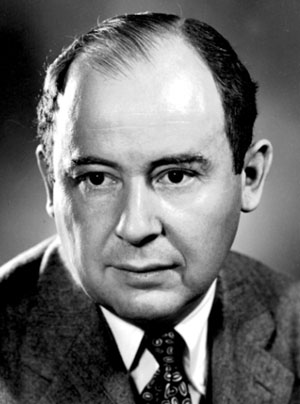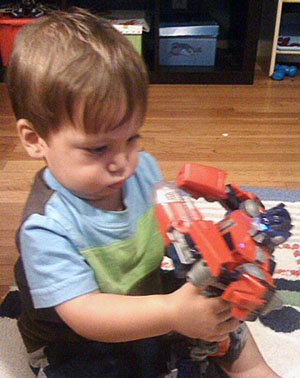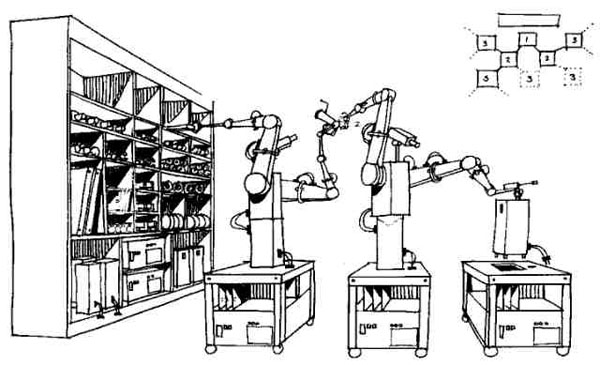Von Neuman, Computers, and Brains
by Krešo Josić
Today, UH math professor Krešo Josić talks about brains, computers and John von Neumann. The University of Houston presents this series about the machines that make our civilization run, and the people whose ingenuity created them.
 The Hungarian American John von Neumann was the last of the great mathematicians. He fundamentally influenced quantum mechanics, economics, computer science ... He was one of the principal members of the Manhattan project, and an advisor to the government on defense policy after World War II. Cancer confined him to a wheelchair near the end of his life. From that seat, he provided a dispassionate analysis of nuclear strategy in accented English. He could well have been the model for Dr. Strangelove.
The Hungarian American John von Neumann was the last of the great mathematicians. He fundamentally influenced quantum mechanics, economics, computer science ... He was one of the principal members of the Manhattan project, and an advisor to the government on defense policy after World War II. Cancer confined him to a wheelchair near the end of his life. From that seat, he provided a dispassionate analysis of nuclear strategy in accented English. He could well have been the model for Dr. Strangelove.
Von Neumann's interest in digital computation was partly driven by the need for fast calculations in nuclear weapon design. In the 1940s he described the architecture used in the first modern computers. He also showed how to construct a self-replicating automaton - a device that could produce copies of itself. For example, he proposed that in the future we could send a handful of robots to the Moon. These automata could reproduce and create an entire colony which could send moon ore back to Earth.
Von Neumann argued that brains, like digital computers, process information and should be studied the way we study computers. He summarized his views in a lecture that he was never able to deliver. He died of cancer in 1956, but his notes for the lecture were printed in a small book The Computer and the Brain. Our understanding of the nervous system and of computer technology has progressed enormously since von Neumann's time. But consider the relevance of some of his ideas:
 He asked to what extent computers and brains are alike. Neuronal cells, the processing units of our brains, respond to inputs in an all-or-none fashion. Their output is digital in character. Yet the brain seems to be at a distinct disadvantage compared with a computer. Even the vacuum tubes used to process information in the first digital computers were much faster than neurons. And the precision with which computers and brains represents information can't be compared.
He asked to what extent computers and brains are alike. Neuronal cells, the processing units of our brains, respond to inputs in an all-or-none fashion. Their output is digital in character. Yet the brain seems to be at a distinct disadvantage compared with a computer. Even the vacuum tubes used to process information in the first digital computers were much faster than neurons. And the precision with which computers and brains represents information can't be compared.
And yet it's clear that our brains are superior in many ways: It took over fifty years to design computers that could consistently win at chess, while artificial intelligence still remains only a dream. A child can tell the difference between a cat and a dog - something no machine can yet do reliably. And just think that our brain uses about as much power as the little light bulb in your refrigerator. How is this possible? Von Neumann pointed out that neurons in our brain work in parallel, while computers process information serially.
By comparing computers and brains within a common framework von Neumann offered us a new way to understand ourselves. More than that, he pointed to a future in which people and computers may draw closer. Machines have already interfaced with brains. We've invented cochlear implants and deep brain stimulation devices that help control Parkinson's disease. And that connection can only become more intimate. That may seem frightening, but consider our relationship with our mobile phone, our laptop, our car ... When we compare that to the role machines played in our grandparent's lives we can bet that electronic devices are destined to become part of us.
I'm Krešo Josić at the University of Houston, where we're interested in the way inventive minds work.
Krešimir Josić is Associate Professor of Mathematics at the University of Houston. His primary interest is mathematical biology and network theory. He is trying to understand how elements of different biological networks work together to process information. He has co-edited the volume Coherent Behavior in Neuronal Networks. (Springer, 2009).
J. von Neumann, The Computer and the Brain. 2nd ed. (see. e.g., the New Haven: Yale University Press, 2000, reprint). This is a short and relatively easy read. It may also be read on line by clicking here.
For more on the Manhattan project and von Neumann's role in it, see: R. Rhodes, The Making of the Atomic Bomb. (New York: Simon & Schuster 1986). See also, the Wikipedia article on von Nuemann. Images: Boy and robot photo by K. Josić, von Neumann photo courtesy of Wikipedia.
The interfacing of brain and machine offers many new ethical challenges, some of which are discussed by J. Clausen, Man, machine and in Between. Nature. 2009 Feb 26;457(7233):1080-1.

Cartoon representation of self-replicating robots. Image courtesy of VizWiki.